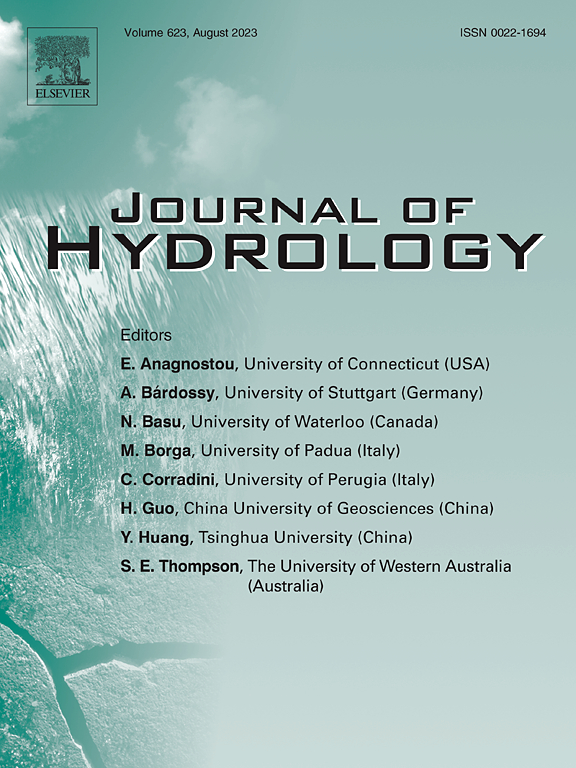Stochastic framework reveals the controls of forest treatment – peakflow causal relations in rain environment
IF 5.9
1区 地球科学
Q1 ENGINEERING, CIVIL
引用次数: 0
Abstract
Decades of literature on forest treatment – peakflow relations have generated considerable disagreements and turned the topic into one regarded as enigmatic. Factors affecting peakflows are multiple and chancy and, hence, can only be investigated via a probabilistic approach. We analyze peakflow data using the peakflow frequency distribution framework in two pairs of control-treatment watersheds in the rain environment of an experimental forest in North Carolina. We demonstrate how a range of forest treatments can change the magnitude and frequency of all peakflows on record and how such effects can increase with increasing event size as a consequence of changes to the peakflow frequency distribution. Changes to the distribution’s mean (−0.2 to +47.4 %) and variance (−30.9 to +162.1 %) resulted in a range of effects from no significant impacts on peakflows to making larger peakflows becoming even larger (up to 105 % increase) and more frequent (up to 18 times more frequent). Changes to peakflows are attributed to treatment-induced suppression of evapotranspiration and changes to non-vegetative factors, which can alter the soil storage capacity, moisture available for runoff, and the efficiency of runoff arriving to the outlet. The dominant topographical aspect of the watershed, seasonal differences in storm types, extent to which the storm events are in-phase or out-of-phase with high antecedent soil moisture, and lagged runoff responses with watershed memory emerged as key indicators of the sensitivity of peakflows to forest treatment. The application of the stochastic framework in forest hydrology can help fully understand forest treatment – peakflows relations.

随机框架揭示了雨环境下森林治理的控制-峰流因果关系
几十年来关于森林治理-峰流关系的文献产生了相当大的分歧,并使这个话题成为一个被认为是神秘的话题。影响峰值流量的因素是多重的和偶然的,因此,只能通过概率方法来研究。我们使用峰流频率分布框架分析了北卡罗莱纳州实验森林雨环境中两对对照处理流域的峰流数据。我们展示了一系列森林处理如何改变记录在案的所有峰流的强度和频率,以及由于峰流频率分布的变化,这种影响如何随着事件规模的增加而增加。分布的平均值(- 0.2至+47.4 %)和方差(- 30.9至+162.1 %)的变化导致了一系列影响,从对峰值流量没有显著影响到使较大的峰值流量变得更大(增加105 %)和更频繁(频率增加18倍)。峰值流量的变化归因于处理引起的蒸散发抑制和非植物因素的变化,这些因素可以改变土壤的储存能力、径流的水分和径流到达出口的效率。流域的主要地形特征、风暴类型的季节差异、风暴事件与高土壤湿度的同期或非同期的程度,以及具有流域记忆的滞后径流响应,成为峰值流量对森林治理敏感性的关键指标。随机框架在森林水文学中的应用有助于充分理解森林治理-峰流关系。
本文章由计算机程序翻译,如有差异,请以英文原文为准。
求助全文
约1分钟内获得全文
求助全文
来源期刊

Journal of Hydrology
地学-地球科学综合
CiteScore
11.00
自引率
12.50%
发文量
1309
审稿时长
7.5 months
期刊介绍:
The Journal of Hydrology publishes original research papers and comprehensive reviews in all the subfields of the hydrological sciences including water based management and policy issues that impact on economics and society. These comprise, but are not limited to the physical, chemical, biogeochemical, stochastic and systems aspects of surface and groundwater hydrology, hydrometeorology and hydrogeology. Relevant topics incorporating the insights and methodologies of disciplines such as climatology, water resource systems, hydraulics, agrohydrology, geomorphology, soil science, instrumentation and remote sensing, civil and environmental engineering are included. Social science perspectives on hydrological problems such as resource and ecological economics, environmental sociology, psychology and behavioural science, management and policy analysis are also invited. Multi-and interdisciplinary analyses of hydrological problems are within scope. The science published in the Journal of Hydrology is relevant to catchment scales rather than exclusively to a local scale or site.
 求助内容:
求助内容: 应助结果提醒方式:
应助结果提醒方式:


